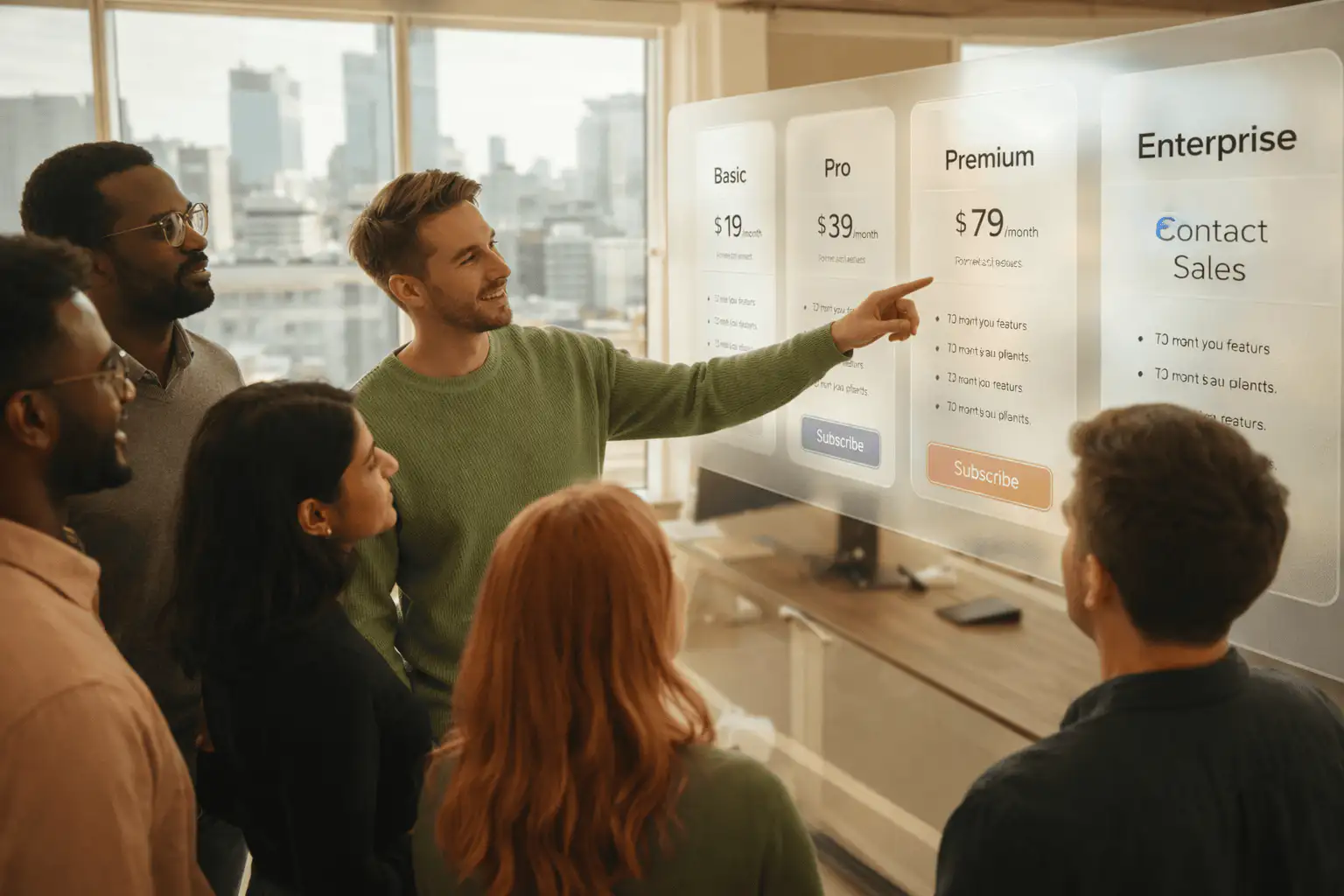Your LinkedIn company page is underperforming. Not because the platform doesn't work. But because you don't know what you're actually measuring.
Most AI companies treat LinkedIn like a vanity metric—post frequently, watch follower count grow, hope something converts. Then they wonder why, despite all that activity, inbound is flat and hiring is still a struggle.
The problem isn't effort. It's clarity.
We've worked with dozens of B2B AI companies, and the ones crushing it on LinkedIn aren't posting more. They're posting with clear outcomes in mind. They understand that a well-run LinkedIn page isn't just a communication channel—it's a business engine that moves multiple levers simultaneously.
Here are the seven outcomes you should be optimizing for. Not all at once. But strategically, over time.
Outcome 1: Increased Brand Authority
What it means: Your company becomes the recognized expert in your space. When enterprise buyers think about your problem category, they think about you first.
Why it matters for AI companies: Authority is everything in a crowded market. There are 10,000 AI companies claiming to solve similar problems. The ones with clear authority win deals at higher valuations and with shorter sales cycles.
How you build it:
The companies doing this well—Gong, HubSpot, IBM Watson—aren't just announcing. They're teaching. They're sharing frameworks, market insights, and contrarian POVs that position their team as experts, not vendors.
Real example: Gong doesn't post "We updated our API." They post "Here's what the best sales teams have in common—we analyzed 100K conversations and found these three patterns." That's authority. That's positioning.
In your 90-day window: You should see your team mentioned in industry conversations. Your founder should be getting inbound opportunities to speak, contribute to publications, or advise. That's brand authority compounding.
Measurement: Are enterprise prospects researching you because they've seen your thought leadership? Are they referencing your insights in conversations? That's the signal authority is building.
Outcome 2: Lead Generation
What it means: Your LinkedIn page becomes a top-of-funnel engine that drives qualified leads directly into your sales process.
Why it matters: LinkedIn users have higher purchase intent than social media users on other platforms. Decision-makers are actively looking for solutions. If your page is positioned right, they find you during their research phase.
How you build it:
This is where specificity matters. Generic thought leadership gets engagement. Specific thought leadership gets leads. When you address a customer's exact challenge—with a framework, a metric, or a story—and your company name is attached to it, you've created a lead magnet.
Real example: B2B Rocket posts about "5 ways your sales team is losing deals due to poor AI implementation" with actual metrics and use cases. Enterprise sales leaders see that, realize it applies to them, and want to know how B2B Rocket approaches the problem.
In your 90-day window: You should see direct inbound from LinkedIn. Sales should be reporting "They found us on LinkedIn" with increasing frequency. Not volume. Frequency. Quality matters more than quantity.
Measurement: Track inbound conversations that started with LinkedIn. Which posts drove them? Double down on that content type.
Outcome 3: Employee Recruitment
What it means: Your company page becomes a recruiting magnet that attracts top talent passively before you ever have an open role.
Why it matters for AI: Talent is your constraint. A strong LinkedIn page that shows your team, your culture, and your market position makes top engineers want to work for you. They're watching before you need them.
How you build it:
This is where behind-the-scenes content and employee spotlights matter. When potential hires see your team actively engaged on LinkedIn, see themselves represented, and understand your company's vision, recruiting becomes inbound.
Real example: HubSpot's page is filled with culture content, employee spotlights, and company milestones. Top marketing and sales talent follow them. When roles open, they have a pipeline of pre-convinced candidates.
In your 90-day window: You should see job applications increase, especially from referrals ("I found you on LinkedIn"). Your team should report that candidates mention your page in interviews ("I've been following your content").
Measurement: Track applications directly referencing your LinkedIn presence. Track time-to-hire for roles promoted on your page. Compare to cold recruiting metrics.
Outcome 4: Media and Publicity Exposure
What it means: Your LinkedIn announcements become credible press hooks that journalists, analysts, and influencers reference and amplify.
Why it matters: A well-positioned LinkedIn announcement about a partnership, funding, or market insight can generate media coverage worth 10x the effort. Journalists follow company pages. They see your announcements and sometimes they cover them.
How you build it:
The key is making your announcements newsworthy. Not just "We raised $X." But "We raised $X to solve this specific market problem that nobody else is addressing." The specificity makes it shareable.
Real example: IBM Watson announces new AI capabilities, but they frame it around enterprise adoption patterns and market transformation. That story is interesting to journalists. It gets covered.
In your 90-day window: You should see your announcements picked up in industry publications. Your founder should be quoted in press. Your company name should appear in analyst reports. That's publicity leverage.
Measurement: Track media mentions that reference your LinkedIn announcements. Track analyst visibility. This compounds over time.
Outcome 5: Improved SEO and Discoverability
What it means: Your LinkedIn page becomes a discovery hub. When enterprise buyers search for solutions in your category, your company appears higher in search results.
Why it matters: Enterprise buyers research before they engage. If you're not discoverable, you miss the entire consideration phase. A strong LinkedIn presence with keyword-rich content improves both LinkedIn search and Google search rankings.
How you build it:
This is tactical. Every post, every company description, every content piece should be optimized for the keywords your target customer uses when searching for your solution.
Real example: If you're an agentic AI platform for enterprise automation, every post should include those keywords naturally. Your about section should use them. Your content should be discoverable when someone searches "enterprise AI automation" or "agentic AI implementation."
In your 90-day window: You should see improvement in search rankings for your key categories. You should see more inbound from organic search leading to your LinkedIn page.
Measurement: Use LinkedIn search to see where you rank for key terms. Use Google Search Console to track visibility improvements. Track organic traffic to your LinkedIn page from search.
Outcome 6: Audience Engagement
What it means: Your page builds a community of engaged followers who consistently interact with your content, share it, and create momentum around your message.
Why it matters: Engagement signals quality to the algorithm. When your followers engage consistently, your posts reach more people. This creates a flywheel where your best content reaches more prospects, who become followers, who engage more.
How you build it:
Engagement comes from content that creates dialogue, not broadcasts. Posts that ask questions, share contrarian views, or invite stories drive engagement. So do posts that respond authentically to comments—your team joining conversations, not just monitoring them.
Real example: Engage AI posts about customer success and asks questions like "What's your biggest friction point in AI implementation?" Comments flood in. The team responds. A conversation happens. The algorithm sees engagement and amplifies the post.
In your 90-day window: Your engagement rate should improve 50%+ (not just likes, but comments and shares). Your posts should generate 30+ meaningful comments consistently. Your audience should start commenting on each other's responses.
Measurement: Track engagement rate (comments + shares / impressions). Track comment quality (are they thoughtful or spam?). Track repeat engagers (are the same people showing up?).
Outcome 7: Customer Trust and Credibility
What it means: Your existing customers see your LinkedIn activity, feel reinforced in their choice, and become advocates. New prospects evaluate your page as part of their due diligence and feel confident in your stability and expertise.
Why it matters: Enterprise buying includes a trust component. When a prospect lands on your LinkedIn page and sees consistent, thoughtful content, customer success stories, and an engaged team, they feel safer buying from you. Trust shortens sales cycles and increases contract value.
How you build it:
This is where transparency matters. Share customer stories (with permission). Show your team actively engaged. Post about challenges, not just wins. Be human. Customers and prospects trust human companies more than polished ones.
Real example: SAP shares diverse content including culture, thought leadership, and customer stories. Enterprise buyers see a mature company with depth and community. They feel safe buying from them.
In your 90-day window: Your sales team should report that prospects mention your LinkedIn page in discovery calls. They should say things like "We liked what we saw on your page" or "We could tell you know what you're doing." That's credibility converting.
Measurement: Ask your sales team to track mentions of your LinkedIn page. Survey customers on their perception of your authority. Track trust signals (NPS, case study requests, expanded deals).
The Seven Outcomes in Action: Real Examples
Let's look at how real B2B AI companies are driving these seven outcomes simultaneously.
Gong
Focus: Sales intelligence and customer engagement
Outcomes they're driving:
- Authority: Regular insights on sales trends and conversation analysis
- Lead Generation: Content about improving deal velocity
- Recruitment: Company culture and team spotlights
- Media: Product announcements picked up by press
- SEO: Consistent keyword-rich content on sales challenges
- Engagement: Comments and shares consistently in the hundreds
- Trust: Transparent data and customer success stories
Result: Top-of-mind in the sales intelligence space. Enterprise buyers default to researching them.
HubSpot
Focus: Marketing automation and CRM
Outcomes they're driving:
- Authority: Thought leadership on inbound marketing
- Lead Generation: Marketing tips that convert to interested prospects
- Recruitment: Strong culture content that attracts talent
- Media: Regular product announcements covered by press
- SEO: Dominant search rankings for marketing keywords
- Engagement: High engagement rates and active community
- Trust: Transparent about strategy and customer success
Result: Recruiting pipeline. Lead generation from LinkedIn. Media coverage. Authority in their space.
IBM Watson
Focus: Enterprise AI and cloud solutions
Outcomes they're driving:
- Authority: Detailed content on enterprise AI implementation
- Lead Generation: Use cases and ROI stories
- Recruitment: Enterprise-scale hiring announcements
- Media: Regular press releases on partnerships
- SEO: Enterprise AI keyword dominance
- Engagement: Consistent engagement from enterprise audience
- Trust: Transparency about AI capabilities and limitations
Result: Top-of-funnel authority. Enterprise credibility. Media visibility.
The Outcome Hierarchy: What Matters Most
Not all outcomes are equal. Here's the hierarchy for different company stages:
Pre-PMF / Seed Stage:
- Authority (establish credibility)
- Lead Generation (get noticed)
- Recruitment (attract talent)
Series A / B:
- Lead Generation (fuel growth)
- Authority (defend market position)
- Recruitment (scale team)
- Media (market credibility)
Growth / Enterprise:
- Authority (defend position)
- Trust and Credibility (larger deals)
- Media (analyst relations)
- Engagement (community building)
Where you are determines which outcomes to prioritize. But all seven compound over time. A company that's intentionally driving all seven doesn't just have a LinkedIn page. They have a business engine.
The 90-Day Outcome Roadmap
Here's how to move all seven outcomes simultaneously:
Weeks 1-4: Foundation + Authority
- Optimize profile (all fields, keywords)
- Establish consistent posting rhythm (weekly minimum)
- Position founder as thought leader (begin posting from personal profile)
- Measurement: Authority signals (are people researching you?)
Weeks 5-8: Lead Generation + Engagement
- Shift content to address specific customer challenges
- Implement employee advocacy (team sharing posts)
- Ask questions that spark dialogue
- Measurement: Inbound from LinkedIn, engagement rate trending up
Weeks 9-12: Trust, Recruitment, Media
- Share customer success stories
- Post team spotlights and culture content
- Make product announcements on LinkedIn
- Measurement: Recruiting pipeline, media mentions, sales team reporting LinkedIn credibility
By Day 90:
- Consistent authority signals (mentions, speaking invites)
- Regular inbound from LinkedIn (10+ qualified leads/month minimum)
- Recruitment interest (applications mentioning your page)
- 50%+ engagement rate improvement
- Improved search visibility
- Sales team leveraging LinkedIn in deals
The Real Insight
A well-run LinkedIn company page doesn't just build followers. It builds business.
The companies crushing it—Gong, HubSpot, IBM Watson, Engage AI—aren't treating LinkedIn as a social platform. They're treating it as a customer acquisition, recruitment, and authority engine.
They understand that consistency, specificity, and human authenticity compound. That one post can drive multiple outcomes. That employee advocacy multiplies reach. That engagement creates algorithm advantage.
They're not guessing. They're optimizing for clear business outcomes.
And they're winning deals, recruiting talent, and building market authority as a result.
Ready to Drive Real Outcomes?
If you're ready to stop posting randomly and start optimizing for clear business outcomes, we'd love to help.
ThoughtCred works with B2B AI companies to develop a LinkedIn strategy that drives all seven of these outcomes simultaneously. We help you establish thought leadership, build audience engagement, generate qualified leads, and create a sustainable competitive advantage.
Let's talk about your LinkedIn outcomes — or explore our success stories to see how B2B AI companies have transformed their LinkedIn presence from a vanity project into a real business engine.



.webp)



.svg)